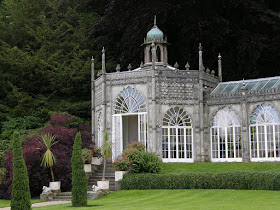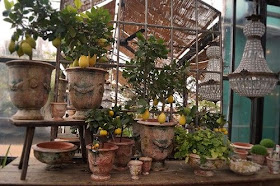I adore potted citrus trees. If you are interested in bringing the elegance of a European garden to your home, there is nothing more lovely than a French Anduze pot complete with citrus tree. This blog post will give you some history on the European citrus trend in the 17th and 18th centuries and hopefully entice you to plant your own citrus tree. I know I intend to.
The countries that started the citrus trend were France, Germany, and the Netherlands, these countries being the ones that saw merchants importing large numbers of orange trees, banana plants, and pomegranates to cultivate for their beauty and scent. It was very fashionable in the summer to have potted citrus trees as part of the landscape where they were used to ornament the formal gardens of the time. Structures similar to a greenhouse or conservatory called orangeries were also built on the grounds of fashionable residences where orange and other fruit trees could be protected during the winter. Orangeries were given a classical architectural form and owners would conduct their guests there on tours of the garden to admire not only the trees but also the architecture. Often the orangery would contain fountains, grottos, and an entertainment area for inclimate weather.The great period of the orangery, when few great gardens were without one, extended from the latter half of the 17th century into the early 18th century.
With the current love of all things French, many are choosing to incorporate citrus trees in their container gardens and then move them into their interiors to weather the cold. So if space is limited or climate isn't suitable, it's still possible to enjoy these trees and their bounty year-round. The experts say it's really not that hard to grow citrus indoors. I hope this blog helps if you are considering growing some for yourself.
Between the 17th-19th century, if you were wealthy and part of the “fashionable” elite, the chances are you would have a display of a great number of orange trees in your garden as well as an elaborate structure called an orangery or orangerie to winter them in within the grounds of your home. Many famous orangeries survive, however those at the gardens of Versailles in France are the most recognized.
The Versailles planter in that fabulous duck egg blue color was designed by Andre Le Nortre, the original designer of the Versailles gardens, in the 1600's and were made entirely out of timber, but in the 1800’s were redesigned to feature the cast-iron frame.You can purchase similar containers today but if they are wood it is a good idea to slow the decay process caused by watering by coating the interior with asphalt roof patch.
the Orangerie at Versailles was designed by Jules Hardouin-Mansart for Louis XIV's 3,000 orange trees.
The Orangerie at Versailles in Spring
As a building the Orangerie is superbly functional; long and narrow with a series of 27 tall windows to admit the winter light. The plain back wall contained fireplaces, from which hot air passed through flues. In its center, the high door through which fully-grown trees could be wheeled into the garden.
The baroque orangery, located next to Kensington Palace in Kensington Gardens, was built in 1704-05.
The orangerie, however, was not just a greenhouse but a symbol of prestige and wealth and a feature of gardens, in the same way as a summerhouse, folly or "Grecian temple". The main difference with a conservatory is in the construction of its roof - a conservatory will have more than 75 per cent of its roof glazed, while an orangerie will have less than 75 per cent glazed. Domestic orangeries also typically feature a roof lantern.
google.co.za
Chatsworth House Orangery
icotswolds.com
Sezincote House Orangery in Gloucestershire
Potted citrus in the Medici Palace garden.
When planting citrus trees choose a pot about the size of a 15-gallon nursery container. In traditional European orangeries, the classic container is 24 inches square and deep. Make plastic your last choice as it will transmit the sun's heat more readily than wood or clay, perhaps enough to damage roots. Fill with premixed sterile potting soil designed for container plants.
The quintessential container for potted citrus trees, the traditional French Anduze pot with it's handcrafted garlands and medallions.
Potted citrus trees ripe with Old World elegance and charm!
Plants in containers generally require more frequent watering than the same plants in open soil, and citrus are no exception. Especially during hot, dry, or windy weather, daily watering may be necessary. The basic rule is to soak the rootball thoroughly until water drains out the bottom once the top 2 to 3 inches of soil are dry. Rewet dry citrus rootballs by placing a few drops of mild dishwashing soap directly onto the soil, then water with slightly warm water.
This kumquat tree with it's small fruit can be accented with flowers to provide visual interest. Citrus trees with larger fruit would probably pull out all the nutrients for themselves so flowers wouldn't thrive as well.
Other citrus will grow and flower but are less likely to produce fruit. However they will still provide lovely accents to your gardens.
via Pinterest
If you hope to harvest fruit, choose a naturally acidic citrus not a sweet orange or grapefruit. Examples of acidic varieties include 'Improved Meyer' and 'Ponderosa' lemons, calamondins, and kumquats. These are most likely to produce fruit indoors in winter.
Any type of citrus tree can grow in a container, at least for a while. However, kinds such as lemon and grapefruit, which naturally grow into larger plants, will quickly outgrow their containers. There are dwarf varieties that will last longer in pots.
Potted citrus trees are perfect for flanking the entrance of this Mediterranean style home.
Potted orange trees at the Musée Matisse in Nice.(photo by Sylvaine Poitau)
If you live in the mild-winter West, Southwest, or Southeast, you can grow most kinds of citrus in container outdoors year-round. Where winter minimum temperatures regularly dip below 25oF, you can still grow citrus trees if you have a bright spot indoors or out protected from frost.
Who wouldn't enjoy dining in this lovely spot? The potted orange trees, rustic farm table and industrial style seating, not to mention the pea gravel........so French!!
An enchanting garden in the South of France designed by Jean-Loup Dirand.
I will take potted citrus trees any way, shape, or size, however, I think they are especially pretty all in a row. Nothing says French like a potted citrus tree . . . or three.
via Pinterest
If you prefer smaller scale fruit for your potted citrus, kumquat, mandarin, and yuzu are good choices. These varieties are more likely to remain both healthy and productive in containers for several years.
What terrace wouldn't benefit from lining it's edge with potted citrus trees? Stone lions also hold court in this outdoor entertainment area.
Supply nutrients to your potted citrus trees with controlled-release fertilizers that are less apt to immediately wash through soil, making a single applications useful for a longer time. More than most plants, citrus are prone to deficiencies of the micronutrients iron, manganese, and zinc so apply these to citrus in containers at least once a year.
Michel Semini Designs with Versailles orangerie planter boxes in green.
When moving your potted citrus trees outdoors in spring or back indoors in fall, make the transition gradual, in at night and out during daylight hours. Do this for approximately a month. Also wash your tree thoroughly with warm, slightly soapy water to wash off bugs before bringing in for the winter.
Many homeowners that love an old world interior are drawn to using potted citrus in their interior landscaping.
Potted citrus and blue and white Chinese export team up well together for great visual impact.
Charm aside, citrus trees as houseplants offer other fabulous rewards........ glossy foliage, scent, and mouthwatering produce.
These might be artificial because they are almost too perfect. Even so, for those of you not blessed with a green thumb this might be the best alternative.
Cathy Kincaid
Whether citrus trees are producing fruit or not, their shiny green leaves are a pretty addition to your interiors. Dwarf citrus trees generally reach a maximum height of eight feet so not much space is needed for creating a small orchard.
The look of potted citrus is so refreshing when brought indoors. When looking for citrus to pot, any that is grafted to Flying Dragon (Hiryu) rootstock will be significantly dwarfed, thereby extending its useful life in a container.
via Pinterest
Citrus trees add a particularly lovely old world component and will provide you with fresh lemons, limes and oranges. What more could you ask for????
Citrus growing tips via the National Gardening Association.
Click here to see the previous post
http://eyefordesignlfd.blogspot.com/2017/07/decorating-with-wall-sconce-shelves.htm
This blog post was published by Lisa Farmer



































